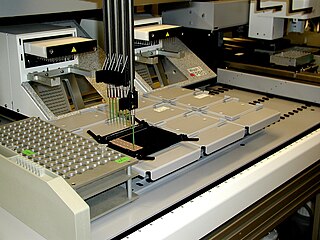Related Research Articles

In biology and biochemistry, a lipid is a macro biomolecule that is soluble in nonpolar solvents. Non-polar solvents are typically hydrocarbons used to dissolve other naturally occurring hydrocarbon lipid molecules that do not dissolve in water, including fatty acids, waxes, sterols, fat-soluble vitamins, monoglycerides, diglycerides, triglycerides, and phospholipids.

The proteome is the entire set of proteins that is, or can be, expressed by a genome, cell, tissue, or organism at a certain time. It is the set of expressed proteins in a given type of cell or organism, at a given time, under defined conditions. Proteomics is the study of the proteome.

Proteomics is the large-scale study of proteins. Proteins are vital parts of living organisms, with many functions. The proteome is the entire set of proteins produced or modified by an organism or system. Proteomics enables the identification of ever-increasing numbers of proteins. This varies with time and distinct requirements, or stresses, that a cell or organism undergoes. Proteomics is an interdisciplinary domain that has benefitted greatly from the genetic information of various genome projects, including the Human Genome Project. It covers the exploration of proteomes from the overall level of protein composition, structure, and activity, and is an important component of functional genomics.
Glycomics is the comprehensive study of glycomes, including genetic, physiologic, pathologic, and other aspects. Glycomics "is the systematic study of all glycan structures of a given cell type or organism" and is a subset of glycobiology. The term glycomics is derived from the chemical prefix for sweetness or a sugar, "glyco-", and was formed to follow the omics naming convention established by genomics and proteomics.

Lipidomics is the large-scale study of pathways and networks of cellular lipids in biological systems The word "lipidome" is used to describe the complete lipid profile within a cell, tissue, organism, or ecosystem and is a subset of the "metabolome" which also includes the three other major classes of biological molecules: proteins/amino-acids, sugars and nucleic acids. Lipidomics is a relatively recent research field that has been driven by rapid advances in technologies such as mass spectrometry (MS), nuclear magnetic resonance (NMR) spectroscopy, fluorescence spectroscopy, dual polarisation interferometry and computational methods, coupled with the recognition of the role of lipids in many metabolic diseases such as obesity, atherosclerosis, stroke, hypertension and diabetes. This rapidly expanding field complements the huge progress made in genomics and proteomics, all of which constitute the family of systems biology.

Metabolomics is the scientific study of chemical processes involving metabolites, the small molecule substrates, intermediates and products of cell metabolism. Specifically, metabolomics is the "systematic study of the unique chemical fingerprints that specific cellular processes leave behind", the study of their small-molecule metabolite profiles. The metabolome represents the complete set of metabolites in a biological cell, tissue, organ or organism, which are the end products of cellular processes. Messenger RNA (mRNA), gene expression data and proteomic analyses reveal the set of gene products being produced in the cell, data that represents one aspect of cellular function. Conversely, metabolic profiling can give an instantaneous snapshot of the physiology of that cell, and thus, metabolomics provides a direct "functional readout of the physiological state" of an organism. One of the challenges of systems biology and functional genomics is to integrate genomics, transcriptomic, proteomic, and metabolomic information to provide a better understanding of cellular biology.
Biomedicine is a branch of medical science that applies biological and physiological principles to clinical practice. Biomedicine stresses standardized, evidence-based treatment validated through biological research, with treatment administered via formally trained doctors, nurses, and other such licensed practitioners.

The metabolome refers to the complete set of small-molecule chemicals found within a biological sample. The biological sample can be a cell, a cellular organelle, an organ, a tissue, a tissue extract, a biofluid or an entire organism. The small molecule chemicals found in a given metabolome may include both endogenous metabolites that are naturally produced by an organism as well as exogenous chemicals that are not naturally produced by an organism.

Sterol is an organic compound with formula C
17H
28O, whose molecule is derived from that of gonane by replacement of a hydrogen atom in position 3 by a hydroxyl group. It is therefore an alcohol of gonane. More generally, any compounds that contain the gonane structure, additional functional groups, and/or modified ring systems derived from gonane are called steroids. Therefore, sterols are a subgroup of the steroids. They occur naturally in most eukaryotes, including plants, animals, and fungi, and can also be produced by some bacteria. The most familiar type of animal sterol is cholesterol, which is vital to cell membrane structure, and functions as a precursor to fat-soluble vitamins and steroid hormones.

Meibomian glands are sebaceous glands along the rims of the eyelid inside the tarsal plate. They produce meibum, an oily substance that prevents evaporation of the eye's tear film. Meibum prevents tears from spilling onto the cheek, traps them between the oiled edge and the eyeball, and makes the closed lids airtight. There are about 25 such glands on the upper eyelid, and 20 on the lower eyelid.
In lipidomics, the process of shotgun lipidomics uses analytical chemistry to investigate the biological function, significance, and sequelae of alterations in lipids and protein constituents mediating lipid metabolism, trafficking, or biological function in cells. Lipidomics has been greatly facilitated by recent advances in, and novel applications of, electrospray ionization mass spectrometry (ESI/MS).

The lipidome refers to the totality of lipids in cells. Lipids are one of the four major molecular components of biological organisms, along with proteins, sugars and nucleic acids. Lipidome is a term coined in the context of omics in modern biology, within the field of lipidomics. It can be studied using mass spectrometry and bioinformatics as well as traditional lab-based methods. The lipidome of a cell can be subdivided into the membrane-lipidome and mediator-lipidome.
Shotgun proteomics refers to the use of bottom-up proteomics techniques in identifying proteins in complex mixtures using a combination of high performance liquid chromatography combined with mass spectrometry. The name is derived from shotgun sequencing of DNA which is itself named after the rapidly expanding, quasi-random firing pattern of a shotgun. The most common method of shotgun proteomics starts with the proteins in the mixture being digested and the resulting peptides are separated by liquid chromatography. Tandem mass spectrometry is then used to identify the peptides.

Saccharolipids are chemical compounds containing fatty acids linked directly to a sugar backbone, forming structures that are compatible with membrane bilayers. In the saccharolipids, a monosaccharide substitutes for the glycerol backbone present in glycerolipids and glycerophospholipids. The most familiar saccharolipids are the acylated glucosamine precursors of the lipid A component of the lipopolysaccharides in Gram-negative bacteria. Typical lipid A molecules are disaccharides of glucosamine, which are derivatized with as many as seven fatty-acyl chains. The minimal lipopolysaccharide required for growth in Escherichia coli is Kdo2-Lipid A, a hexa-acylated disaccharide of glucosamine (LipidA) that is glycosylated with two 3-deoxy-D-manno-octulosonic acid (Kdo) residues.
Edward Marcotte is a professor of biochemistry at The University of Texas at Austin, working in genetics, proteomics, and bioinformatics. Marcotte is an example of a computational biologist who also relies on experiments to validate bioinformatics-based predictions.

Lipidology is the scientific study of lipids. Clinical studies on lipid metabolism in the body have led to developments in therapeutic lipidology for disorders such as cardiovascular disease.

Ronald Charles Beavis is a Canadian protein biochemist, who has been involved in the application of mass spectrometry to protein primary structure, with applications in the fields of proteomics and analytical biochemistry. He has developed methods for measuring the identity and post-translational modification state of proteins obtained from biological samples using mass spectrometry. He is currently best known for developing new methods for analyzing proteomics data and applying the results of these methods to problems in computational biology.
The 'German Network for Bioinformatics Infrastructure – de.NBI' is a national, academic and non-profit infrastructure supported by the Federal Ministry of Education and Research providing bioinformatics services to users in life sciences research and biomedicine in Germany and Europe. The partners organize training events, courses and summer schools on tools, standards and compute services provided by de.NBI to assist researchers to more effectively exploit their data.
References
- ↑ Fahy E, Subramaniam S, Murphy RC, Nishijima M, Raetz CR, Shimizu T, Spener F, van Meer G, Wakelam MJ, Dennis EA (April 2009). "Update of the LIPID MAPS comprehensive classification system for lipids". Journal of Lipid Research. 50 Suppl (S1): S9-14. doi:10.1194/jlr.R800095-JLR200. PMC 2674711 . PMID 19098281.
- ↑ Valeria Pereira Serafim P, Figueiredo JR, de Adiel G, Vitor Felipe A, Guimaraes Lo Turco E, Silva, Manoukian Forones N (2019). "STUDY OF LIPID BIOMARKERS OF PATIENTS WITH POLYPS AND COLORECTAL CÂNCER". Arquivos de Gastroenterologia. 56 (4): 399–404. doi: 10.1590/S0004-2803.201900000-80 . PMID 31800736.
- ↑ Zheng H, Yang R, Wang Z, Wang J, Zhang J, Sun H (2020). "Characterization of pharmaceutic structured triacylglycerols by high‐performance liquid chromatography/tandem high‐resolution mass spectrometry and its application to structured fat emulsion injection". Rapid Communications in Mass Spectrometry. 34 (1): e8557. doi: 10.1002/rcm.8557 . PMID 31429125.
- ↑ Sasaki H, White SH (2008). "Aggregation Behavior of an Ultra-Pure Lipopolysaccharide that Stimulates TLR-4 Receptors". Biophysical Journal. 95 (2): 986–993. Bibcode:2008BpJ....95..986S. doi:10.1529/biophysj.108.129197. PMC 2440428 . PMID 18375521.
- ↑ Muralikrishna Adibhatla R, Hatcher JF (2007). "Role of lipids in brain injury and diseases". Future Lipidology. 2 (4): 403–422. doi:10.2217/17460875.2.4.403. PMC 2174836 . PMID 18176634.
- ↑ "Phat on potential, lipidomics is gaining weight". Eureka Alert. 10 January 2019. Retrieved 10 June 2020.
- ↑ "Lipidomics – A Niche but Rapidly Growing Field". Technology Networks. 11 September 2019. Retrieved 10 June 2020.
- ↑ Sud M, Fahy E, Cotter D, et al. (January 2007). "LMSD: LIPID MAPS structure database". Nucleic Acids Res. 35 (Database issue): D527–32. doi:10.1093/nar/gkl838. PMC 1669719 . PMID 17098933.
- ↑ Cotter D, Maer A, Guda C, Saunders B, Subramaniam S (January 2006). "LMPD: LIPID MAPS proteome database". Nucleic Acids Res. 34 (90001): D507–10. doi:10.1093/nar/gkj122. PMC 1347484 . PMID 16381922.
- ↑ Fahy E, Alvarez-Jarreta J, Brasher CJ, Nguyen A, Hawksworth JI, Rodrigues P, Meckelmann S, Allen SM, O'Donnell VB (2019). "LipidFinder on LIPID MAPS: peak filtering, MS searching and statistical analysis for lipidomics". Bioinformatics. 35 (4): 685–687. doi:10.1093/bioinformatics/bty679. PMC 6378932 . PMID 30101336.
- ↑ Sud M, Fahy E, Cotter D, Dennis EA, Subramaniam S (December 2011). "LIPID MAPS-Nature Lipidomics Gateway: An Online Resource for Students and Educators Interested in Lipids". Journal of Chemical Education. 89 (2): 291–292. doi:10.1021/ed200088u. PMC 3995124 . PMID 24764601.
- ↑ "Service list". elixir-europe.org. Retrieved 10 June 2020.
- ↑ Ferry, Georgina (24 April 2020). "Michael Wakelam obituary". The Guardian. Manchester. Retrieved 10 June 2020.